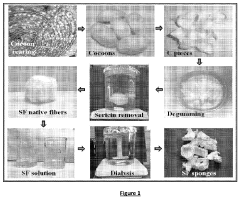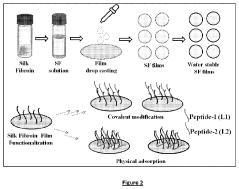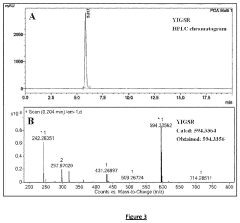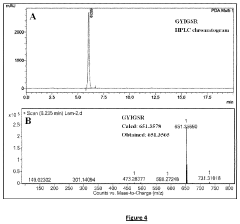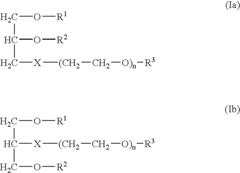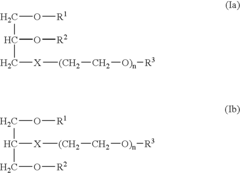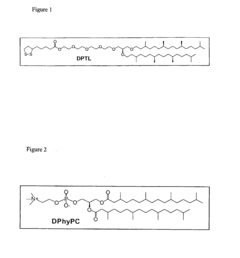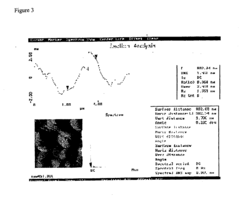Progressive Traits of Cellophane in Bio-Mimetic Systems
JUL 9, 20259 MIN READ
Generate Your Research Report Instantly with AI Agent
Patsnap Eureka helps you evaluate technical feasibility & market potential.
Cellophane Biomimicry Background and Objectives
Cellophane, a transparent sheet made from regenerated cellulose, has emerged as a fascinating subject in the field of biomimicry. The study of cellophane's progressive traits in bio-mimetic systems represents a convergence of materials science, biology, and engineering, aiming to unlock nature-inspired solutions for various technological challenges.
The journey of cellophane in biomimetic research began with the recognition of its unique properties, particularly its transparency, flexibility, and biodegradability. These characteristics closely mimic those found in certain biological structures, such as plant cell walls and insect wings. As researchers delved deeper into the molecular structure and behavior of cellophane, they discovered its potential to serve as a model for developing advanced materials with enhanced functionalities.
The evolution of cellophane research in biomimetic systems has been driven by the growing need for sustainable and eco-friendly materials across various industries. From packaging to medical applications, the demand for materials that can replicate the efficiency and adaptability of natural systems has never been higher. Cellophane, with its plant-based origin and biodegradable nature, presents an ideal candidate for such explorations.
One of the primary objectives in studying cellophane's progressive traits is to understand and replicate its molecular organization. The unique arrangement of cellulose molecules in cellophane contributes to its remarkable properties, and researchers aim to harness this knowledge to design new materials with similar or enhanced characteristics. This includes exploring ways to improve the material's barrier properties, mechanical strength, and responsiveness to environmental stimuli.
Another key goal is to investigate the potential of cellophane-inspired materials in developing smart, adaptive systems. By studying how cellophane interacts with its environment and responds to various stimuli, researchers hope to create materials that can self-regulate, self-heal, or change properties based on external conditions. This could lead to breakthroughs in areas such as responsive packaging, dynamic membranes, and adaptive biomedical devices.
The research on cellophane in biomimetic systems also aims to address some of the material's limitations, such as its moisture sensitivity and relatively low heat resistance. By understanding these challenges through the lens of biomimicry, scientists seek to develop improved versions or entirely new materials that overcome these drawbacks while maintaining cellophane's beneficial properties.
As we progress in this field, the ultimate objective is to translate the insights gained from cellophane biomimicry into practical, sustainable solutions for real-world problems. This includes developing new manufacturing processes inspired by natural cellulose production, creating multi-functional materials that can serve in diverse applications, and contributing to the broader goal of transitioning towards a more sustainable and bio-inspired technological landscape.
The journey of cellophane in biomimetic research began with the recognition of its unique properties, particularly its transparency, flexibility, and biodegradability. These characteristics closely mimic those found in certain biological structures, such as plant cell walls and insect wings. As researchers delved deeper into the molecular structure and behavior of cellophane, they discovered its potential to serve as a model for developing advanced materials with enhanced functionalities.
The evolution of cellophane research in biomimetic systems has been driven by the growing need for sustainable and eco-friendly materials across various industries. From packaging to medical applications, the demand for materials that can replicate the efficiency and adaptability of natural systems has never been higher. Cellophane, with its plant-based origin and biodegradable nature, presents an ideal candidate for such explorations.
One of the primary objectives in studying cellophane's progressive traits is to understand and replicate its molecular organization. The unique arrangement of cellulose molecules in cellophane contributes to its remarkable properties, and researchers aim to harness this knowledge to design new materials with similar or enhanced characteristics. This includes exploring ways to improve the material's barrier properties, mechanical strength, and responsiveness to environmental stimuli.
Another key goal is to investigate the potential of cellophane-inspired materials in developing smart, adaptive systems. By studying how cellophane interacts with its environment and responds to various stimuli, researchers hope to create materials that can self-regulate, self-heal, or change properties based on external conditions. This could lead to breakthroughs in areas such as responsive packaging, dynamic membranes, and adaptive biomedical devices.
The research on cellophane in biomimetic systems also aims to address some of the material's limitations, such as its moisture sensitivity and relatively low heat resistance. By understanding these challenges through the lens of biomimicry, scientists seek to develop improved versions or entirely new materials that overcome these drawbacks while maintaining cellophane's beneficial properties.
As we progress in this field, the ultimate objective is to translate the insights gained from cellophane biomimicry into practical, sustainable solutions for real-world problems. This includes developing new manufacturing processes inspired by natural cellulose production, creating multi-functional materials that can serve in diverse applications, and contributing to the broader goal of transitioning towards a more sustainable and bio-inspired technological landscape.
Market Analysis for Bio-Inspired Cellophane Applications
The market for bio-inspired cellophane applications is experiencing significant growth, driven by increasing demand for sustainable and biodegradable materials across various industries. Cellophane, a thin transparent sheet made from regenerated cellulose, has gained renewed interest due to its potential in biomimetic systems. The global market for bio-based and biodegradable plastics, which includes cellophane, is projected to reach substantial value in the coming years.
The food packaging industry represents a major market segment for bio-inspired cellophane applications. With growing consumer awareness of environmental issues, there is a shift towards eco-friendly packaging solutions. Cellophane's natural properties, such as biodegradability and transparency, make it an attractive alternative to traditional plastic packaging. The food and beverage sector, in particular, is showing increased adoption of cellophane-based packaging materials.
Another promising area for cellophane applications is in the medical and pharmaceutical industries. The biocompatibility and adaptability of cellophane make it suitable for various medical applications, including drug delivery systems and wound dressings. The healthcare sector's focus on innovative, bio-inspired materials is expected to drive further growth in this segment.
The textile industry is also exploring cellophane-based materials for sustainable fashion and technical textiles. The ability to mimic natural fibers while offering enhanced properties has sparked interest among textile manufacturers and designers. This trend aligns with the growing demand for eco-friendly and high-performance fabrics in the fashion and sportswear markets.
In the electronics sector, cellophane's potential in flexible and biodegradable electronics is gaining attention. As the industry moves towards more sustainable and recyclable components, cellophane-based materials could play a crucial role in developing eco-friendly electronic devices and packaging.
The agricultural sector presents another significant market opportunity for bio-inspired cellophane applications. Biodegradable mulch films and seed coatings made from cellophane-based materials offer environmentally friendly alternatives to traditional plastic products used in agriculture.
Geographically, North America and Europe are currently leading the market for bio-inspired cellophane applications, driven by stringent environmental regulations and consumer preferences for sustainable products. However, the Asia-Pacific region is expected to witness the fastest growth, fueled by rapid industrialization, increasing environmental awareness, and government initiatives promoting sustainable materials.
The food packaging industry represents a major market segment for bio-inspired cellophane applications. With growing consumer awareness of environmental issues, there is a shift towards eco-friendly packaging solutions. Cellophane's natural properties, such as biodegradability and transparency, make it an attractive alternative to traditional plastic packaging. The food and beverage sector, in particular, is showing increased adoption of cellophane-based packaging materials.
Another promising area for cellophane applications is in the medical and pharmaceutical industries. The biocompatibility and adaptability of cellophane make it suitable for various medical applications, including drug delivery systems and wound dressings. The healthcare sector's focus on innovative, bio-inspired materials is expected to drive further growth in this segment.
The textile industry is also exploring cellophane-based materials for sustainable fashion and technical textiles. The ability to mimic natural fibers while offering enhanced properties has sparked interest among textile manufacturers and designers. This trend aligns with the growing demand for eco-friendly and high-performance fabrics in the fashion and sportswear markets.
In the electronics sector, cellophane's potential in flexible and biodegradable electronics is gaining attention. As the industry moves towards more sustainable and recyclable components, cellophane-based materials could play a crucial role in developing eco-friendly electronic devices and packaging.
The agricultural sector presents another significant market opportunity for bio-inspired cellophane applications. Biodegradable mulch films and seed coatings made from cellophane-based materials offer environmentally friendly alternatives to traditional plastic products used in agriculture.
Geographically, North America and Europe are currently leading the market for bio-inspired cellophane applications, driven by stringent environmental regulations and consumer preferences for sustainable products. However, the Asia-Pacific region is expected to witness the fastest growth, fueled by rapid industrialization, increasing environmental awareness, and government initiatives promoting sustainable materials.
Current Challenges in Cellophane-Based Biomimetic Systems
Despite the promising potential of cellophane in biomimetic systems, several significant challenges currently hinder its widespread application and optimal performance. One of the primary obstacles is the limited control over the material's mechanical properties. While cellophane exhibits remarkable flexibility and transparency, fine-tuning its strength, elasticity, and durability to match specific biological structures remains a complex task.
Another critical challenge lies in the biocompatibility of cellophane-based systems. Although cellophane is generally considered safe for biological applications, ensuring long-term compatibility with living tissues and minimizing potential immune responses requires further research and development. This is particularly crucial for applications in medical implants or tissue engineering.
The scalability of cellophane-based biomimetic systems presents another significant hurdle. While small-scale prototypes have shown promise, translating these successes to large-scale production while maintaining consistent quality and performance is a considerable challenge. This includes issues related to manufacturing processes, quality control, and cost-effectiveness.
Moisture sensitivity is a persistent issue in cellophane-based systems. The material's tendency to absorb water can lead to changes in its physical properties and potentially compromise the integrity of the biomimetic structure. Developing effective moisture barriers or modifying cellophane's hydrophilic nature without sacrificing its desirable traits is an ongoing area of research.
The biodegradability of cellophane, while generally an advantage, can be a double-edged sword in certain biomimetic applications. Controlling the rate of degradation to match the intended lifespan of the biomimetic system is crucial, especially in scenarios where long-term stability is required.
Furthermore, the integration of cellophane with other materials and components in complex biomimetic systems poses significant challenges. Achieving seamless interfaces between cellophane and other biological or synthetic materials, as well as incorporating electronic or sensing elements, requires innovative approaches in material science and engineering.
Lastly, the environmental impact of cellophane production and disposal, although less severe compared to many synthetic polymers, still presents challenges. Developing more sustainable production methods and ensuring proper end-of-life management for cellophane-based biomimetic systems are important considerations for the future of this technology.
Another critical challenge lies in the biocompatibility of cellophane-based systems. Although cellophane is generally considered safe for biological applications, ensuring long-term compatibility with living tissues and minimizing potential immune responses requires further research and development. This is particularly crucial for applications in medical implants or tissue engineering.
The scalability of cellophane-based biomimetic systems presents another significant hurdle. While small-scale prototypes have shown promise, translating these successes to large-scale production while maintaining consistent quality and performance is a considerable challenge. This includes issues related to manufacturing processes, quality control, and cost-effectiveness.
Moisture sensitivity is a persistent issue in cellophane-based systems. The material's tendency to absorb water can lead to changes in its physical properties and potentially compromise the integrity of the biomimetic structure. Developing effective moisture barriers or modifying cellophane's hydrophilic nature without sacrificing its desirable traits is an ongoing area of research.
The biodegradability of cellophane, while generally an advantage, can be a double-edged sword in certain biomimetic applications. Controlling the rate of degradation to match the intended lifespan of the biomimetic system is crucial, especially in scenarios where long-term stability is required.
Furthermore, the integration of cellophane with other materials and components in complex biomimetic systems poses significant challenges. Achieving seamless interfaces between cellophane and other biological or synthetic materials, as well as incorporating electronic or sensing elements, requires innovative approaches in material science and engineering.
Lastly, the environmental impact of cellophane production and disposal, although less severe compared to many synthetic polymers, still presents challenges. Developing more sustainable production methods and ensuring proper end-of-life management for cellophane-based biomimetic systems are important considerations for the future of this technology.
Existing Cellophane Biomimetic Solutions
01 Cellophane with improved mechanical properties
Development of cellophane with enhanced strength, flexibility, and durability. This involves modifications to the cellulose structure or the addition of reinforcing materials to improve the overall mechanical performance of cellophane films.- Cellophane with progressive biodegradability: Development of cellophane materials with progressive biodegradable traits, allowing for controlled decomposition over time. This innovation addresses environmental concerns by creating packaging materials that break down naturally, reducing long-term waste accumulation.
- Improved optical properties of cellophane: Advancements in cellophane manufacturing to enhance its optical properties, including transparency and light transmission. These improvements make cellophane more suitable for various applications, such as packaging and display materials, where visual clarity is crucial.
- Enhanced mechanical strength of cellophane: Techniques to increase the mechanical strength and durability of cellophane, making it more resistant to tearing and stretching. This allows for the production of thinner yet stronger cellophane films, suitable for demanding packaging applications.
- Cellophane with progressive moisture barrier properties: Development of cellophane with adjustable moisture barrier properties, allowing for controlled permeability to water vapor. This innovation enables the creation of packaging materials that can maintain optimal humidity levels for various products over time.
- Cellophane with progressive heat-sealing capabilities: Advancements in cellophane formulations to provide progressive heat-sealing properties, allowing for improved packaging integrity and seal strength over time. This innovation enhances the versatility of cellophane in various packaging applications.
02 Biodegradable and eco-friendly cellophane
Creation of cellophane variants that are more environmentally friendly and biodegradable. This includes the use of sustainable raw materials and the incorporation of additives that promote faster decomposition without compromising the film's functional properties.Expand Specific Solutions03 Cellophane with enhanced barrier properties
Improvement of cellophane's barrier properties against moisture, gases, and other substances. This involves the development of multi-layer structures or the incorporation of specific additives to enhance the film's ability to protect packaged contents.Expand Specific Solutions04 Functionalized cellophane for specific applications
Development of cellophane with added functionalities such as antimicrobial properties, UV resistance, or heat-sealability. These modifications expand the range of applications for cellophane in various industries, including food packaging and medical supplies.Expand Specific Solutions05 Improved production processes for cellophane
Advancements in the manufacturing processes of cellophane to enhance efficiency, reduce environmental impact, and improve product quality. This includes innovations in cellulose dissolution, film formation, and post-treatment techniques.Expand Specific Solutions
Key Players in Cellophane Biomimetic Research
The research on progressive traits of cellophane in bio-mimetic systems is in an emerging stage, with a growing market potential as sustainable packaging solutions gain traction. The technology is still developing, with varying levels of maturity across different applications. Key players like Kemira Oyj and CoorsTek are advancing industrial applications, while academic institutions such as the University of California, Columbia University, and McGill University are driving fundamental research. The involvement of government agencies like the National Research Council of Canada and the Agency for Science, Technology & Research indicates strategic importance. As the field evolves, collaboration between industry and academia will be crucial for commercialization and scaling of bio-inspired cellophane technologies.
Agency for Science, Technology & Research
Technical Solution: The Agency for Science, Technology & Research (A*STAR) has developed a novel approach to bio-mimetic systems using cellophane as a key component. Their research focuses on creating progressive traits in cellophane that mimic natural biological systems. A*STAR's scientists have engineered cellophane to exhibit dynamic properties such as self-healing and adaptive permeability[1]. By incorporating nanoparticles and responsive polymers into the cellophane matrix, they have achieved a material that can change its structure and function in response to environmental stimuli[3]. This bio-inspired cellophane has shown potential in applications ranging from smart packaging to artificial skin for robotics[5].
Strengths: Advanced research capabilities, interdisciplinary approach, and strong industry collaborations. Weaknesses: Potential scalability issues and high development costs.
South China University of Technology
Technical Solution: South China University of Technology has made significant strides in cellophane-based bio-mimetic systems. Their research team has developed a method to create hierarchical structures in cellophane that mimic the architecture of plant cell walls[2]. By controlling the orientation and arrangement of cellulose nanofibrils within the cellophane, they have achieved materials with enhanced mechanical properties and unique anisotropic behaviors[4]. The university has also explored the incorporation of bio-derived additives to impart functionalities such as antimicrobial properties and controlled biodegradability to the cellophane[6]. Their work has shown promising results in creating sustainable packaging materials and biomedical scaffolds.
Strengths: Strong focus on sustainable and bio-inspired materials, expertise in cellulose-based technologies. Weaknesses: May face challenges in large-scale production and commercialization.
Core Innovations in Progressive Cellophane Traits
A composite, scaffold and applications thereof
PatentInactiveUS20200155726A1
Innovation
- A biomaterial composite comprising silk fibroin and melanin, optionally modified with laminin-derived peptides, is developed, which is biocompatible, electroactive, and free radical scavenging, enabling the creation of scaffolds with improved cell adhesion, proliferation, and myogenic differentiation capabilities.
Biomimetic systems consisting of lipid membranes bound to a substrate
PatentInactiveUS20040023304A1
Innovation
- Development of tethering lipids with a carrier comprising hydroxy, thiol, or amino groups, combined with saturated or unsaturated hydrocarbon residues and an oligoethylene oxide group, which enable robust anchoring to substrates while maintaining lateral mobility, thereby forming supported lipid bilayers with improved electrical properties.
Environmental Impact of Cellophane Biomimetics
The environmental impact of cellophane biomimetics is a crucial aspect to consider in the development and application of this technology. As cellophane-based biomimetic systems gain traction in various industries, it is essential to evaluate their ecological footprint and potential consequences on the environment.
One of the primary environmental benefits of cellophane biomimetics is the potential reduction in plastic waste. Traditional plastics, derived from fossil fuels, contribute significantly to pollution and environmental degradation. In contrast, cellophane, being a biodegradable material derived from renewable resources such as wood pulp or cotton linters, offers a more sustainable alternative. The bio-based nature of cellophane ensures that it can decompose naturally, reducing the accumulation of persistent waste in landfills and oceans.
However, the production process of cellophane still has environmental implications that need to be addressed. The manufacturing of cellophane involves chemical treatments and energy-intensive processes, which can contribute to greenhouse gas emissions and water pollution if not properly managed. As research in cellophane biomimetics progresses, there is a growing focus on developing more eco-friendly production methods to mitigate these impacts.
The use of cellophane in biomimetic systems also presents opportunities for energy conservation and improved resource efficiency. By mimicking natural structures and processes, cellophane-based materials can potentially enhance the performance of various products while using fewer resources. For instance, cellophane-inspired packaging solutions could provide better barrier properties with less material, reducing overall waste and energy consumption in the packaging industry.
Furthermore, the biodegradability of cellophane offers advantages in applications where material recovery is challenging. In sectors such as agriculture or marine environments, cellophane-based products could naturally decompose without leaving harmful residues, unlike conventional plastics. This characteristic is particularly valuable in addressing the issue of microplastic pollution, which poses a significant threat to ecosystems and wildlife.
Despite these potential benefits, it is crucial to conduct comprehensive life cycle assessments to fully understand the environmental impact of cellophane biomimetics. Factors such as raw material sourcing, production energy requirements, transportation, and end-of-life disposal must be carefully evaluated to ensure that the overall environmental footprint is indeed lower than that of conventional alternatives.
As research in this field advances, there is a growing emphasis on developing cellophane biomimetic systems that not only mimic natural structures but also incorporate principles of circular economy and sustainability. This approach aims to create materials and products that are not only biodegradable but also recyclable or reusable, further minimizing their environmental impact throughout their lifecycle.
One of the primary environmental benefits of cellophane biomimetics is the potential reduction in plastic waste. Traditional plastics, derived from fossil fuels, contribute significantly to pollution and environmental degradation. In contrast, cellophane, being a biodegradable material derived from renewable resources such as wood pulp or cotton linters, offers a more sustainable alternative. The bio-based nature of cellophane ensures that it can decompose naturally, reducing the accumulation of persistent waste in landfills and oceans.
However, the production process of cellophane still has environmental implications that need to be addressed. The manufacturing of cellophane involves chemical treatments and energy-intensive processes, which can contribute to greenhouse gas emissions and water pollution if not properly managed. As research in cellophane biomimetics progresses, there is a growing focus on developing more eco-friendly production methods to mitigate these impacts.
The use of cellophane in biomimetic systems also presents opportunities for energy conservation and improved resource efficiency. By mimicking natural structures and processes, cellophane-based materials can potentially enhance the performance of various products while using fewer resources. For instance, cellophane-inspired packaging solutions could provide better barrier properties with less material, reducing overall waste and energy consumption in the packaging industry.
Furthermore, the biodegradability of cellophane offers advantages in applications where material recovery is challenging. In sectors such as agriculture or marine environments, cellophane-based products could naturally decompose without leaving harmful residues, unlike conventional plastics. This characteristic is particularly valuable in addressing the issue of microplastic pollution, which poses a significant threat to ecosystems and wildlife.
Despite these potential benefits, it is crucial to conduct comprehensive life cycle assessments to fully understand the environmental impact of cellophane biomimetics. Factors such as raw material sourcing, production energy requirements, transportation, and end-of-life disposal must be carefully evaluated to ensure that the overall environmental footprint is indeed lower than that of conventional alternatives.
As research in this field advances, there is a growing emphasis on developing cellophane biomimetic systems that not only mimic natural structures but also incorporate principles of circular economy and sustainability. This approach aims to create materials and products that are not only biodegradable but also recyclable or reusable, further minimizing their environmental impact throughout their lifecycle.
Intellectual Property Landscape in Biomimetic Cellophane
The intellectual property landscape in biomimetic cellophane is characterized by a diverse array of patents and innovations, reflecting the growing interest in this field. Major players in the industry, including both established companies and emerging startups, have been actively filing patents to protect their advancements in cellophane-based biomimetic systems.
One significant trend in the patent landscape is the focus on improving the biodegradability and sustainability of cellophane materials. Several patents have been filed for novel manufacturing processes that incorporate bio-based additives or utilize renewable resources to enhance the environmental profile of cellophane products. These innovations aim to address the increasing demand for eco-friendly packaging solutions while maintaining the desirable properties of traditional cellophane.
Another prominent area of patent activity revolves around enhancing the barrier properties of cellophane for various applications. Researchers have developed and patented new coating technologies and surface treatments that improve moisture resistance, gas permeability, and overall durability of cellophane films. These advancements have expanded the potential applications of cellophane in food packaging, medical devices, and other industries requiring high-performance barrier materials.
The patent landscape also reveals a growing interest in functionalized cellophane materials. Numerous patents describe methods for incorporating active compounds, such as antimicrobial agents or antioxidants, into cellophane films. These innovations aim to create intelligent packaging solutions that can extend shelf life, monitor product quality, or provide additional benefits to consumers.
Biomimetic approaches to cellophane development have gained traction in recent years, as evidenced by an increasing number of patents in this area. Researchers have drawn inspiration from natural structures and processes to create cellophane-based materials with enhanced properties. For example, patents have been filed for cellophane films that mimic the structure of plant cell walls to improve strength and flexibility.
Geographically, the patent landscape for biomimetic cellophane is distributed across multiple regions, with significant activity in North America, Europe, and Asia. The United States, Japan, and Germany are among the leading countries in terms of patent filings, reflecting their strong research and development capabilities in this field.
In conclusion, the intellectual property landscape in biomimetic cellophane is dynamic and diverse, with innovations spanning multiple aspects of material science and engineering. As research in this field continues to advance, it is likely that we will see further patent activity and technological breakthroughs in the coming years.
One significant trend in the patent landscape is the focus on improving the biodegradability and sustainability of cellophane materials. Several patents have been filed for novel manufacturing processes that incorporate bio-based additives or utilize renewable resources to enhance the environmental profile of cellophane products. These innovations aim to address the increasing demand for eco-friendly packaging solutions while maintaining the desirable properties of traditional cellophane.
Another prominent area of patent activity revolves around enhancing the barrier properties of cellophane for various applications. Researchers have developed and patented new coating technologies and surface treatments that improve moisture resistance, gas permeability, and overall durability of cellophane films. These advancements have expanded the potential applications of cellophane in food packaging, medical devices, and other industries requiring high-performance barrier materials.
The patent landscape also reveals a growing interest in functionalized cellophane materials. Numerous patents describe methods for incorporating active compounds, such as antimicrobial agents or antioxidants, into cellophane films. These innovations aim to create intelligent packaging solutions that can extend shelf life, monitor product quality, or provide additional benefits to consumers.
Biomimetic approaches to cellophane development have gained traction in recent years, as evidenced by an increasing number of patents in this area. Researchers have drawn inspiration from natural structures and processes to create cellophane-based materials with enhanced properties. For example, patents have been filed for cellophane films that mimic the structure of plant cell walls to improve strength and flexibility.
Geographically, the patent landscape for biomimetic cellophane is distributed across multiple regions, with significant activity in North America, Europe, and Asia. The United States, Japan, and Germany are among the leading countries in terms of patent filings, reflecting their strong research and development capabilities in this field.
In conclusion, the intellectual property landscape in biomimetic cellophane is dynamic and diverse, with innovations spanning multiple aspects of material science and engineering. As research in this field continues to advance, it is likely that we will see further patent activity and technological breakthroughs in the coming years.
Unlock deeper insights with Patsnap Eureka Quick Research — get a full tech report to explore trends and direct your research. Try now!
Generate Your Research Report Instantly with AI Agent
Supercharge your innovation with Patsnap Eureka AI Agent Platform!
